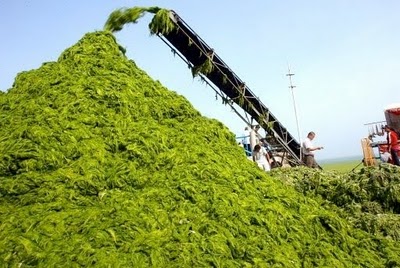
Can local biorefineries pyrolize their waste and by-products, to generate eco friendly sources of energy and chemical compounds via algal biomass super-refineries?
The Dandelion Model: Two-step biofuels technologies and the emergence of algal biomass super-refineries
Two-step process could be the choice for algal biomass refineries in the possible near future, as reported by an Iowa State group.

Imagine, for a moment, a algal biomass biorefinery the magnitude of an oil refinery – competing on equivalent size, generating equal monetary and tax benefits as in enhanced depreciation.
The problem?
The steeply-priced expense of obtaining sufficient algal biomass within, let’s say, a 50-mile area distance. Following roughly 50 miles when small-scale commercial vehicles are utilized, a little bit more when barges or alternatively railroad are used – the typical expenditures including shipping and delivery untreated biomass end up unfeasible. Plenty of oxygen, in addition to a large amount of water – the load is usually a monster.
That’s a primary issue why local algal biomass biorefineries within the bio-space hardly ever go over 25 million gallons regarding projects with agricultural by-products, 50 million gallons for woody biomass, and 250 million gallons concerning waste materials or crop-based oils.
Subsequently, it’s a factor why biofuels experience difficulties in vying with standard fuels gallon-for-gallon. It’s one explanation why technological innovations tend to be so appealing in cases where they concentrate on the creation of dense resources of natural product – such as, algae biofuels ventures and even photo voltaic fuels, among the kind of which Joule is scaling further up.
Alternatives concerning the aggregation issue: the dandelion’s hub and spoke system
An interesting work-around having obtained capital during the last few years continues to be the development of biofuels through which transportation professionals describe as the hub-and-spoke design.
Yet mother nature offers us a existing example – the dandelion.
Within these circumstances, scaled-down algal biomass projects produce refinery intermediates rather than finished fuels. They are at this stage transferred in a very densified application to large refineries where they’re turned into finished fuels and chemical compounds.
It’s been discussed over for a long-time utilizing for example, pyrolysis oils and biocrudes. From the businesses like KiOR, Ensyn or Dynamotive who make these types of intermediates, no two create the same products and solutions.
Nonetheless they share four characteristics:
- Their outcomes can’t be employed immediately as transportation fuels;
- They could be somewhat economical to produce;
- They operate proficiently by using a number of feedstocks;
- Additionally they could be given to refineries for improving.
Just how dense is dense?

Corn stover in its typical (moist) state has around 5500 BTUs per pound. Raw crude oil boasts near three times that amount (16,500 BTUs), and bio-oils usually fall inside the mid-point range (11000 BTUs) among the two.
Presently, you can transfer corn stover, as mentioned, around 50 miles prior to it being feasibly uneconomical. Nevertheless, as almost any pupil of the Gulf of Mexico’s geography knows, you can transport $90 raw crude oil over a lot of miles of Gulf, and the immediate and ongoing expenses calculate rather well.
Exactly what distance is it necessary to transport algal biomass to create a super-refinery? Essentially, provided it is possible to support a 25 million gallon cellulosic biomass enterprise around, let’s say, a 50 mile radius area – consequently a 500 mile radius area might support a 2.5 billion gallon enterprise.
Densify the development of biomass from producing, let’s say, high-volume energy harvest crops and even algal biomass – and that’s the kind of scenario that could result in a million barrel a day biorefinery.
The gasification obstacle
One specific hurdle to this kind of engineering development is simply the ability to efficiently gasify bio-oil, within a refinery facilities, to create a manageable syngas which may be catalytically turned into fuels and chemical compounds. So to illustrate how the two-step process could function inexpensively – given that it’s essential that you put in high temperature to generate bio-oil, followed by it’s necessary to heat it all once again within a refinery establishment.
The Iowa State Project Algae Biomass Project
To deal with those issues, the DOE put in place a two-year, $1 million undertaking with Iowa State University – combined with the Iowa Energy Center which added $450,000 over 3 years. Mike Krapfl, at Iowa State, writes:

“In the Iowa State project, biomass is fed into a fast pyrolysis machine where it’s quickly heated without oxygen. The resulting bio-oil is sprayed into the top of the gasifier where heat and pressure vaporize it to produce a combination of (mostly) hydrogen and carbon monoxide that’s called synthesis gas.”
“The bio-oil gasifier has been fully operational since June and has been converting bio-oil made from pine wood into synthesis gas. As the project moves beyond its startup phase, researchers will use bio-oil produced by Iowa State researchers and fast pyrolysis equipment.”
“Song-Charng Kong, an associate professor of mechanical engineering who’s leading the latter project, will build a computer simulation model of bio-oil gasification. The model will take into account changes in temperature, pressure and biomass. It will allow researchers to understand, predict and ultimately improve the gasification process.”
“The project will also develop a systems simulation tool that allows researchers to examine the technical, economic and big picture implications of bio-oil gasification. And finally, the project will develop a virtual reality model of a full-size plant that will allow researchers to see, study and improve a plant before construction crews are ever hired.”
“The physics and chemistry will be behind all these models and images,” Kong said. “This is a very new area to study. We can use these models as a tool to understand what will happen as this technology is scaled up.”
“We hope to be able to use cellulosic biomass as opposed to using corn grain for the production of fuels,” said Robert C. Brown, the director of Iowa State’s Bioeconomy Institute, an Anson Marston Distinguished Professor in Engineering and the Gary and Donna Hoover Chair in Mechanical Engineering. “This helps us move toward cellulosic biofuels.”
The super-refinery, a definition: Where you can change technologies via numerous organizations and processes

There’s something truly powerful concerning the idea of algal biomass super-refineries – that accomplish numerous techniques to convert syngas to produce high-value fuels and chemical substances. Like syngas fermentation design with the likes of INEOS Bio, LanzaTech or Coskata, in addition to more regular catalysis systems from Rentech.
Further work is essential to grasp the perfect balance in the two-step process. Precisely how small-scale can the system to generate pyrolyizing algal biomass really become – locally community-based or regionally-based?
What size can a bio-oil modernizing refinery become – regional or super-regional? Plus precisely where could this kind of refinery be located – perhaps, for example, down the Mississippi River from the heartland’s farm belt?
The conclusion
Hub and spoke is a powerful technique. It’s in the early stages of development of this kind of system. Nevertheless, it’s an attractive idea that a Local Biorefineries might gather and pyrolize its algal biomass, make use of barges or rail to move it to a super-refinery, after which obtain a supply of fuels and chemical products as an outcome to help fuel a localized economic system produced from a low-cost source of energy.
Which might produce a very respectable approach depending on how the Midwest – as well as other international farming areas will obtain their transport fuels in the foreseeable future.
You also be interested in...

Algae Animal Feed
Most algae have a natural high protein content while a high oil content is mostly achieved though manipulation of cultivation conditions. Read More

Algae Bioplastics
“The day where we hit 95 dollars a barrel I think all of a sudden you’re going to see algae bio-plastics basically explode,” That day has come...Read More

Algae in Aquaculture
From fish farms to fish food, algae aquaculture is booming. With the rising price of fish food many aquaculturists are growing their own...Read More
The Algae Revolution Has Begun
It will Be Our Bible...
Dear sir:
Great news! You are finishing to write one book expected for many years. During several months, I have been an constant follower of your ideas, papers and designs and there is no doubt of your worldwide mastery about biofuels. I am a Colombian researcher dedicated to participate in the Colombian project for production of biodiesel from native microalgae…. It will be as our Bible on those topics really urgent and necessary for the future wellfare of the humanity.
Thanks in advance
UNIVERSIDAD PEDAGOGICA Y TECNOLOGICA DE COLOMBIA




